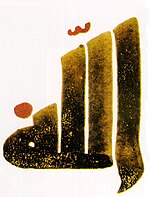Shihab al-Din 'Umar al-Suhrawardi
Shahāb al-Din Abu Hafs Umar Al-Suhrawardi | |
|---|---|
 Manuscript of Suhrawardi's Kitab 'auwarf al-ma'arf. Copy created in Cairo, dated 30 March-29 April 1362 | |
| Title | Shaykh al-Islam |
| Personal life | |
| Born | c. 1145 |
| Died | 1234 (aged c. 89) |
| Resting place | Mausoleum of Umar Suhrawardi |
| Notable work(s) | Awarif al-Ma'arif |
| Other names | Shahabudin, Shahabuddin, Soharwardi, al-Suhrawardi, Soharwardy, Shahab ad-Din |
| Religious life | |
| Religion | Islam, Sunni |
| Denomination | Sunni |
| Order | Suhrawardi Sufi Order |
| Senior posting | |
| Post | Shaykh al-Islam of the Abbasīd Caliphate |
| Period in office | 12th-13th century |
| Part of a series on Islam Sufism |
|---|
 |
|
|
Shahab al-Din Abu Hafs Umar al-Suhrawardi (c. 1145 – 1234) was a Persian[1][2] Sufi and nephew of Abu al-Najib Suhrawardi. He expanded the Sufi order of Suhrawardiyya that had been created by his uncle Abu al-Najib Suhrawardi, and is the person responsible for officially formalizing the order.[3] Suhrawardi is the author of the ʿAwārif al-Maʿārif, which is recognized as a masterpiece work in Tasawwuf.
Life
[edit]Suhrawardi traced his lineage back to Abu Bakr, the first Caliph. From an early age onwards, Suhrawardi studied Islamic jurisprudence, law, logic, theology, Quranic studies and Hadith studies.[4] Suhrawardi quickly excelled in his studies and mastered, at an early age, the Shafi'i and Hanbali madhabs.[4] Suhrawardi was eventually designated as Shaykh al-Islam by Caliph al-Nasir under the Abbasids.[4]
The ʿAwārif al-Maʿārif
[edit]Suhrawardi wrote the ʿAwārif al-Maʿārif (translated as "Benefits of Intimate Knowledge", or other as "The Knowledge of the Spiritually Learned").[5][6] The ʿAwārif al-Maʿārif quickly became one of the most popular books on Sufism throughout the Muslim world. This book was allegedly translated into English by Henry Wilberforce-Clarke and published as "A Dervish Textbook" in 1891, although the Persian text which was the basis for this translation is likely to have been misattributed. It was reprinted by Octagon Press in 1980.
Gallery
[edit]-
Umar Al Suhrawardi's tomb in Baghdad 1912
-
Umar Al Suhrawardi's tomb in Baghdad 1912
See also
[edit]References
[edit]- ^ Medieval Islamic Civilization: An Encyclopedia. New York: Routledge. 2006. p. 775. ISBN 0415966906. Retrieved 2015-03-19.
- ^ John Renard, "Historical dictionary of Sufism ", Rowman & Littlefield, 2005. pg xxviii. excerpt: "Abu 'n-Najib 'Abd al-Qahir as-Suhrawardi, Persian shaykh and author, and scholar who thought Ahmad al-Ghazali, Najm al-Din Kubra and Abu Hafs 'Umar as-Suhrawardi
- ^ Josef W. Meri (2006). L. Bacharach, Jere (ed.). Medieval Islamic Civilization An Encyclopedia · Volume 1 (Hardcover). Routledge. p. 775. ISBN 9780415966900. Retrieved 3 March 2024.
- ^ a b c Medieval Islamic Civilization: An Encyclopedia (2006), p. 775
- ^ Kars, Aydogan (2020-11-17). "An Earlier Copy of al-Suhrawardī's ʿAwārif al-Maʿārif and Its Scribe, Abū Ṭāhir al-Ḥanafī". Religions. 11 (11): 613. doi:10.3390/rel11110613. ISSN 2077-1444.
- ^ Medieval Islamic Civilization: An Encyclopedia (2006), p. 776
Sources
[edit]- Babaie, Sussan (2019). Iran After the Mongols. Bloomsbury Publishing. ISBN 978-1788315289.
- Ohlander, Erik, Sufism in an Age of Transition: Umar al-Suhrawardi and the Rise of the Islamic Mystical Brotherhood (Leiden, Brill, 2008) (Islamic History and Civilization, 71).
- Huda, Qamar-ul, Striving for Divine Union: Spiritual Exercises for Suhrawardī Sūfīs (Psychology Press, 2003)
- Sobieroj, F. (1997). "Suhrawardiyya". In Bosworth, C. E.; van Donzel, E.; Heinrichs, W. P. & Lecomte, G. (eds.). The Encyclopaedia of Islam, Second Edition. Volume IX: San–Sze. Leiden: E. J. Brill. pp. 784–786. ISBN 978-90-04-10422-8.



